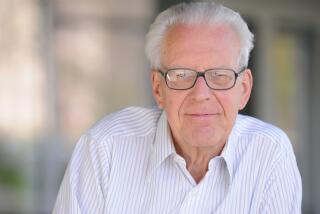Neutrinos Make UCI Prof a Star
- Share via
Frederick Reines said he only had a few minutes to talk. The UC Irvine physics professor was being deluged Tuesday by telephone calls from colleagues and news organizations.
“It’s not like this hasn’t happened before in my life, but, my god, I’m getting older,” he said.
Reines (pronounced RYE-ness) was 37 when, in 1956, he and the late Clyde L. Cowan Jr. discovered the first direct evidence of the existence of neutrinos--subatomic particles so fast and small that they can pass through matter without touching it. The achievement assured the researchers’ place in scientific history.
Now at age 68 Reines says he is just as excited. The detection of a spurt of neutrinos from an exploding star, or supernova, has the astrophysics community abuzz, and the telephone of the discoverer of the neutrino is ringing off the hook.
“There are people walking around on air,” Reines said, because they have won the scientific equivalent of a lottery, cashing in big on what Reines described as “a lousy bet.”
The search for a supernova near enough to Earth for close study “has been going on for a very long time,” but research is hindered by their rarity, he said. The last supernova reported in our galaxy was nearly 400 years ago.
As the theory of how supernovas behave became more sophisticated, “people began to get more and more concerned: If it happens only once in hundreds of years, maybe we should get ready for it. You know, just pie in the sky, a lousy bet, but if you win, isn’t that nice.”
All it required, he said, was fulfilling a series of “ifs.”
“If it happens while you happen to be looking, and if it happens to be close by, then you’re just Lucky Pierre. And if it happens that you’re instrumented to see it and it’s big enough--it’s a lot of ifs. These conditions are very rare. But it’s getting a chance to look inside a supernova. I mean, my gosh!”
All those “ifs” occurred last month, and ironically, it was a neutrino detector in Ohio, built without supernovas in mind, that provided the necessary confirmation.
The detector--a lake of water and instruments at the bottom of a salt mine in Ohio--was built under the supervision of a group of researchers mainly from the University of Michigan and UCI, Reines among them.
“We built it for the purpose of checking proton decay . . . but it turned out that if a supernova happened, big enough and close enough, we could see it with our detector.”
Reines and his colleagues at UCI first learned of the supernova by reading about it in a newspaper, he said. “So we said, hey, you know--not excited at first--but, hey, we really ought to look. What have we got to lose, huh? So we start to look.”
Tapes Double Checked
Data tapes were ordered from the Ohio detector, and they were checked at both Michigan and UCI. After days of painstaking computer analysis, neither found the surge of neutrinos that the Italian and Russian physicists had reported.
“We’re thinking, ‘Gee, maybe the Italians are wrong,’ ” said Robert Svoboda, a research physicist at UCI, but the search continued.
“Some of us come in Saturday, and there’s a message on our computer terminal from friends in Hawaii: The Japanese (physicists) had seen something at this time--this hour, this minute, this second.” It was a different time than the Russians and Italians had reported.
The UCI researchers went over their tapes again, and at the time the Japanese reported, a similar surge of neutrinos appeared in the Ohio data.
Svoboda rushed to the telephone to call colleagues in Hawaii. Others began to hurriedly take down the data, even though there was no hurry. Others were exclaiming in the room where the data was being displayed on computer screens. Others were coming in to see what was causing the excitement.
It was confirmation of much of the theories of supernovas, Reines said.
Evidence Overwhelming
“One experiment of such a kind, especially when it’s not going to be repeated for 400 years, is not proof . It could be a fluky thing. But two experiments on opposite sides of the earth--put these together and juxtapose them and the argument becomes sort of overpowering, overwhelming. And although we’ve been trying as best we can to say, ‘Really, are we sure?’, we can find no way to discredit this.”
It is such rare moments of gratification that are the researchers’ rewards, Reines said.
“This young fellow (Svoboda) has been at it for seven years,” Reines said. “I spent 25 years looking for a certain interaction (to prove the existence of neutrinos) and found it.
“What on earth is in your head? Why do you do this? It’s a question of creativity and patience and a little craziness,” he said.
Exploding star is called biggest astronomical event in 20 years. Part I, Page 3.






